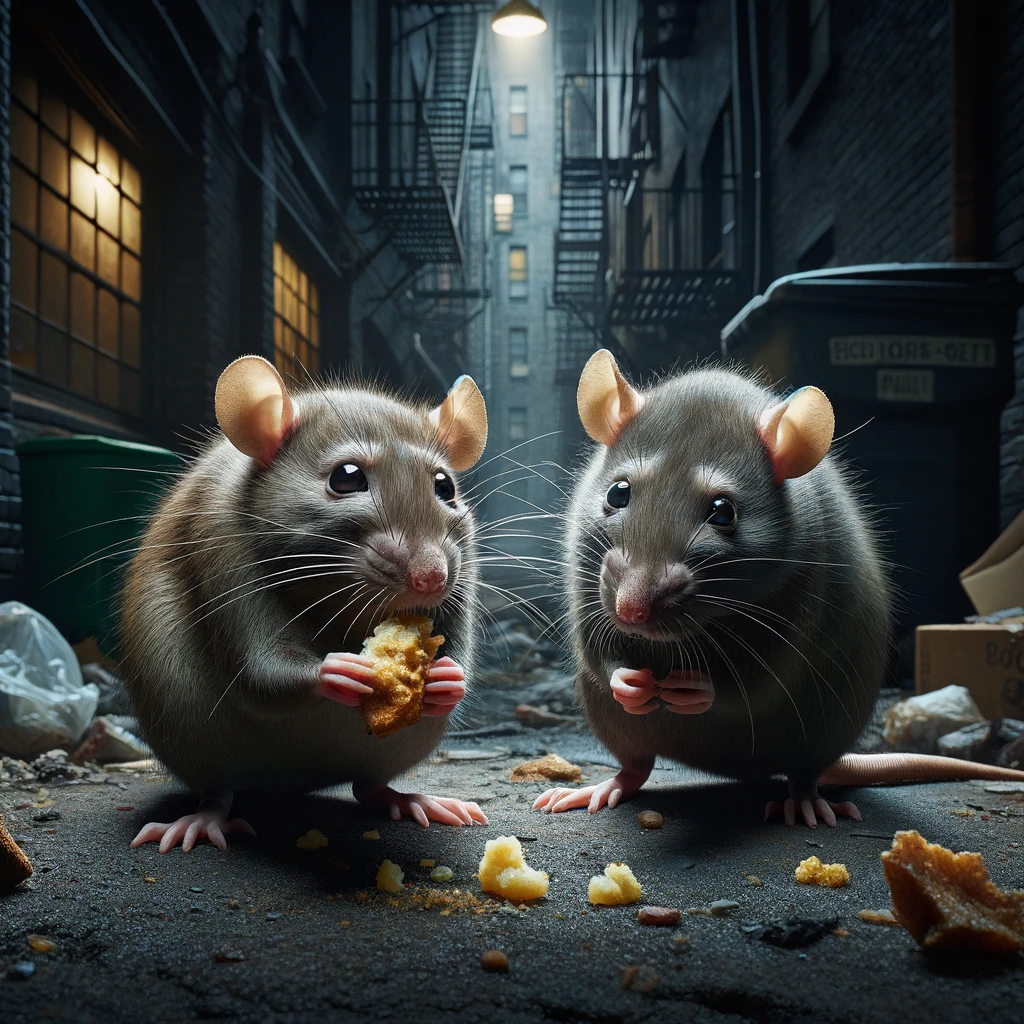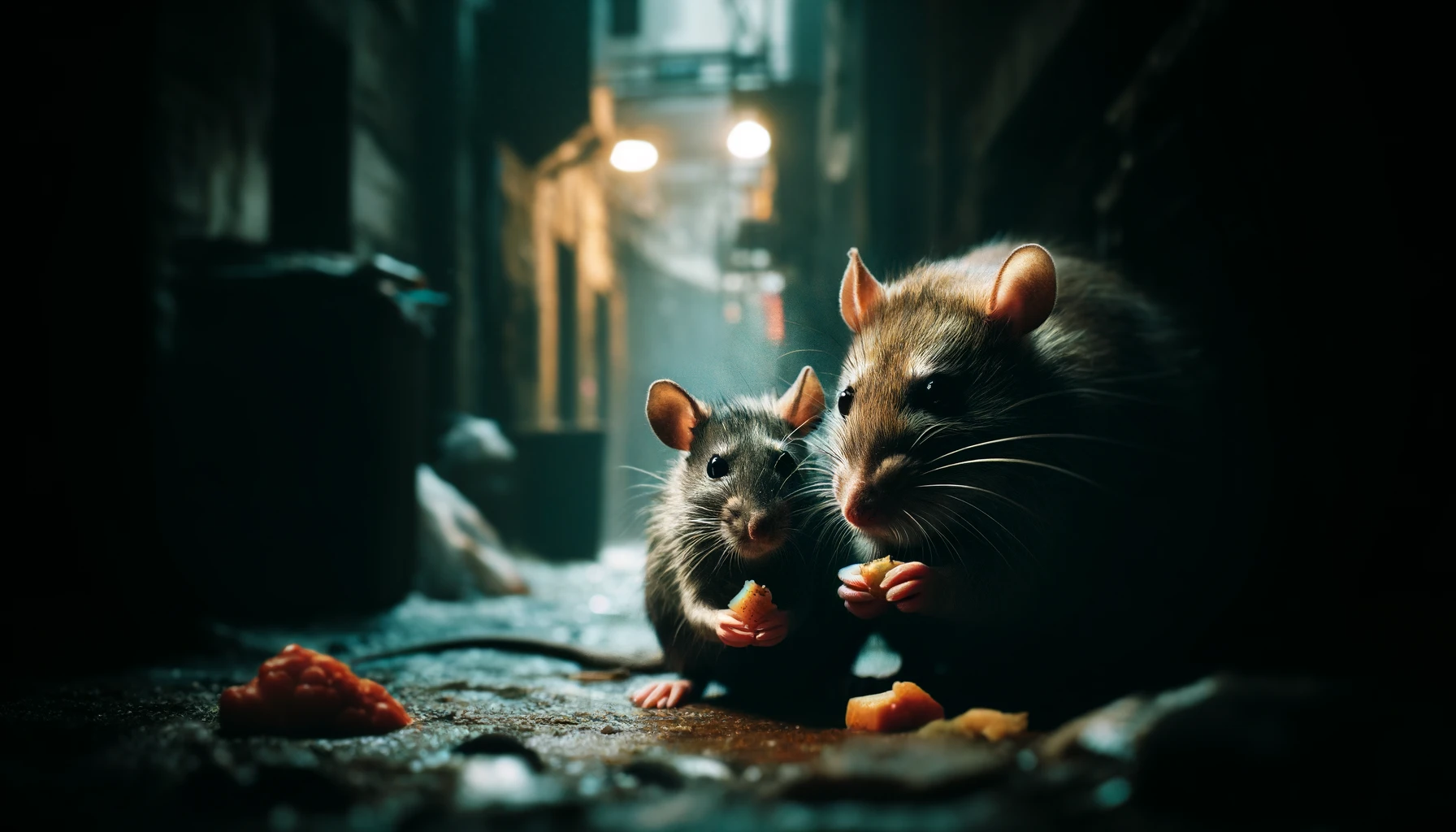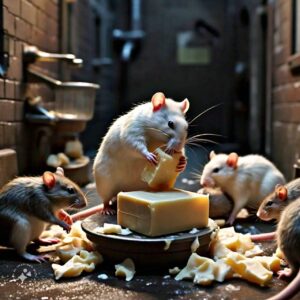Cannibalism in the Rat World: Understanding the Phenomenon
Rats, known for their adaptability and survival instincts, have a dark side that may shock many – cannibalism. While it might seem unnatural, cannibalistic behavior among rats is not uncommon. In this article, we will delve into the world of rat cannibalism, exploring the reasons behind this phenomenon and its implications for both wild and captive rat populations.
Firstly, it is essential to understand that cannibalism in rats is not a random or senseless act. In most cases, it is a survival mechanism triggered by specific environmental factors or physiological needs. One of the primary reasons for cannibalism among rats is food scarcity. When resources are limited, rats may resort to eating their own kind to survive. This behavior is particularly prevalent in high-density populations where competition for food is fierce.
Another factor that contributes to rat cannibalism is stress. When rats are subjected to stressful situations, such as overcrowding, lack of hiding spaces, or excessive handling, they may become more aggressive and turn on each other. This stress-induced cannibalism is often seen in laboratory settings where rats are housed in suboptimal conditions.
Moreover, cannibalism can also occur as a result of maternal instincts. Female rats have been known to eat their own young if they perceive them as weak, sick, or if the litter is too large to support. This behavior, known as infanticide, is a way for the mother to allocate resources to the healthiest and most viable offspring, thus ensuring the survival of her genes.
It is worth noting that not all rat species exhibit the same level of cannibalistic behavior. Some species, such as the Norway rat (Rattus norvegicus), are more prone to cannibalism than others. This variation can be attributed to differences in social structure, habitat, and evolutionary history.
The implications of rat cannibalism are far-reaching. In the wild, cannibalism can have a significant impact on population dynamics. It can serve as a form of population control, preventing overpopulation and resource depletion. However, it can also lead to the spread of diseases, as cannibalism provides a direct route for pathogens to transfer from one individual to another.
In captive settings, such as laboratories or pet homes, cannibalism can be a serious concern. It can lead to the loss of valuable research subjects or beloved pets, and can also cause significant distress to the animals involved. To minimize the risk of cannibalism, it is crucial to provide rats with adequate space, hiding places, and a balanced diet. Regular monitoring and prompt separation of aggressive individuals can also help prevent tragic outcomes.
In conclusion, cannibalism in the rat world is a complex and multifaceted phenomenon. It is driven by a combination of environmental, physiological, and social factors, and has significant implications for both wild and captive rat populations. By understanding the underlying causes of this behavior, we can develop strategies to minimize its occurrence and ensure the well-being of these fascinating creatures. As we continue to study rats and their behavior, it is important to approach the topic of cannibalism with a scientific and compassionate lens, recognizing it as a natural, albeit unsettling, aspect of their biology.

Factors That Drive Rats to Eat Their Own Kind
Cannibalism, the act of consuming members of one’s own species, is a behavior observed across various animal kingdoms, including rats. While it may seem like a disturbing and unnatural practice, there are several factors that can drive rats to engage in cannibalistic behavior. In this article, we will explore the key reasons behind this phenomenon, shedding light on the complex interplay of environmental, physiological, and social influences that shape rat behavior.
- Food Scarcity and Resource Competition
One of the primary factors that can trigger cannibalism in rats is a lack of food. When resources are scarce, rats may resort to eating their own kind as a means of survival. This is particularly common in high-density populations where competition for food is intense. In such situations, the strongest and most dominant rats may prey on the weaker or more vulnerable individuals to ensure their own survival. - Nutritional Deficiencies
In addition to overall food scarcity, specific nutritional deficiencies can also contribute to cannibalistic behavior in rats. For example, a lack of protein or essential amino acids in their diet may drive rats to seek out alternative sources of these nutrients, including the bodies of other rats. This is especially true for pregnant or nursing females, who have higher nutritional demands to support their developing offspring. - Stress and Aggression
Stressful living conditions can also play a significant role in promoting cannibalism among rats. When rats are subjected to overcrowding, lack of hiding spaces, or frequent disturbances, they may become more aggressive and prone to attacking and consuming their cage mates. This stress-induced aggression can be further exacerbated by hormonal imbalances or changes in social hierarchy within the group. - Maternal Cannibalism
Maternal cannibalism, also known as infanticide, is another factor that can drive rats to eat their own kind. Female rats may consume their own young if they perceive them as weak, sick, or if the litter is too large to support. This behavior is thought to be an adaptive strategy that allows the mother to allocate resources to the healthiest and most viable offspring, thus increasing their chances of survival. - Genetic and Evolutionary Factors
Cannibalism in rats may also have a genetic component, with some individuals or populations being more predisposed to this behavior than others. Evolutionary pressures, such as the need to eliminate potential competitors or to gain valuable nutrients, may have shaped the prevalence of cannibalism in certain rat species over time. However, more research is needed to fully understand the role of genetics and evolution in this complex behavior. - Environmental Toxins and Contaminants
Exposure to environmental toxins and contaminants may also contribute to cannibalistic behavior in rats. Studies have shown that rats exposed to certain pollutants, such as heavy metals or pesticides, may display increased aggression and abnormal behavior, including cannibalism. These toxins can disrupt normal brain function and alter neurotransmitter levels, leading to changes in behavior and social interactions. - Social Structure and Dominance Hierarchies
Finally, the social structure and dominance hierarchies within rat populations can influence the likelihood of cannibalism. In some cases, dominant individuals may assert their power by attacking and consuming subordinate members of the group. This behavior may serve to reinforce social bonds, eliminate potential rivals, or maintain the stability of the hierarchy.
In conclusion, the factors that drive rats to eat their own kind are complex and multifaceted. From food scarcity and nutritional deficiencies to stress, maternal instincts, and social dynamics, a wide range of influences can contribute to this unsettling behavior. By understanding these underlying factors, we can develop more effective strategies for managing and preventing cannibalism in both wild and captive rat populations. However, it is important to approach this topic with a scientific and compassionate perspective, recognizing that cannibalism, while disturbing to humans, is a natural and adaptive behavior in the context of rat biology and ecology.
The Risks and Consequences of Rat Cannibalism
Cannibalism, the act of consuming members of one’s own species, is a behavior observed in various animal populations, including rats. While this behavior may serve as a survival mechanism in certain contexts, it also poses significant risks and consequences for both individual rats and entire populations. In this article, we will explore the potential dangers associated with rat cannibalism, focusing on the health, ecological, and social implications of this unsettling phenomenon.
- Disease Transmission and Spread
One of the most significant risks associated with rat cannibalism is the potential for disease transmission. When rats consume the flesh of their own kind, they are exposed to a wide range of pathogens, including viruses, bacteria, and parasites. These pathogens can be easily transferred from the consumed individual to the cannibal, leading to the spread of infectious diseases within the population. Some of the most common diseases associated with rat cannibalism include Tyzzer’s disease, rat-bite fever, and leptospirosis. - Nutritional Deficiencies and Health Issues
While cannibalism may provide rats with a temporary source of nutrients, it is not a balanced or sustainable diet in the long term. Rats that rely heavily on cannibalism may develop nutritional deficiencies, as the bodies of their own kind do not provide all the essential nutrients required for optimal health. This can lead to a range of health issues, including stunted growth, weakened immune systems, and reduced reproductive success. Moreover, consuming the flesh of sick or diseased individuals can further compound these health problems. - Population Dynamics and Ecological Balance
Cannibalism can have significant impacts on the population dynamics and ecological balance of rat communities. In high-density populations where cannibalism is prevalent, the behavior can serve as a form of population control, reducing competition for resources and limiting population growth. However, this can also lead to skewed age and sex ratios, as certain individuals (e.g., young or female rats) may be more vulnerable to cannibalism. Over time, these imbalances can disrupt the natural social structure and reproductive cycles of the population, leading to long-term ecological consequences. - Behavioral and Psychological Effects
Engaging in cannibalistic behavior can also have profound effects on the individual rats involved. Cannibalism is often associated with increased aggression, stress, and social instability within rat populations. Rats that regularly engage in cannibalism may display heightened levels of anxiety, fear, and aggression towards their cage mates, leading to a breakdown of social bonds and increased conflict within the group. These behavioral changes can have long-lasting psychological impacts, affecting the overall well-being and quality of life of the individuals involved. - Implications for Captive Populations
In captive settings, such as laboratories or pet homes, the risks and consequences of rat cannibalism are particularly significant. Cannibalism can lead to the loss of valuable research subjects, compromising the integrity and reliability of scientific studies. In pet populations, the emotional toll of losing a beloved animal to cannibalism can be devastating for owners. Additionally, the presence of cannibalism in captive populations can indicate underlying issues with husbandry, such as inadequate space, poor nutrition, or social stress, which need to be addressed to ensure the welfare of the animals. - Evolutionary and Ecological Trade-offs
While cannibalism may offer short-term benefits for individual rats, such as increased access to nutrients or reduced competition, it also poses significant long-term risks and consequences for the population as a whole. The evolutionary and ecological trade-offs associated with cannibalism are complex and multifaceted, and the behavior may not always be adaptive in the long run. For example, the spread of diseases through cannibalism can lead to population crashes and local extinctions, while the disruption of social structures and reproductive cycles can hamper the long-term viability of the population.
In conclusion, the risks and consequences of rat cannibalism are far-reaching and significant. From disease transmission and nutritional deficiencies to behavioral and psychological effects, this unsettling behavior poses a range of challenges for both individual rats and entire populations. In captive settings, the implications of cannibalism are particularly concerning, highlighting the importance of providing appropriate living conditions and social environments for these animals. By understanding the complex interplay of factors that contribute to rat cannibalism, we can develop more effective strategies for managing and mitigating its impacts, ensuring the health, welfare, and long-term sustainability of rat populations.
Preventing and Managing Cannibalistic Behavior in Pet Rats
As much as we love and care for our pet rats, it can be deeply disturbing to witness or even suspect cannibalistic behavior among them. Cannibalism, while a natural occurrence in wild rat populations, is often a sign of underlying issues in captive settings. In this article, we will discuss various strategies for preventing and managing cannibalistic behavior in pet rats, ensuring their physical and psychological well-being.
- Provide Adequate Space and Housing
One of the primary factors contributing to cannibalism in pet rats is overcrowding and insufficient living space. Rats are social animals that require ample room to move, explore, and establish their own territories. When housed in cramped or overcrowded cages, rats can become stressed, aggressive, and more prone to cannibalistic behavior. To prevent this, ensure that your rats have a spacious, well-ventilated cage with plenty of hiding spots, tunnels, and levels for enrichment. - Ensure Proper Nutrition and Diet
Nutritional deficiencies and imbalances can also trigger cannibalistic behavior in pet rats. It is crucial to provide your rats with a balanced, species-appropriate diet that meets all their nutritional needs. Commercial rat pellets should form the basis of their diet, supplemented with fresh fruits, vegetables, and occasional protein sources. Avoid overfeeding sugary or fatty treats, as these can lead to obesity and health issues. If you suspect that your rats’ diet is lacking, consult with a veterinarian who specializes in exotic pets to develop a suitable feeding plan. - Maintain a Stable Social Structure
Rats are highly social creatures that thrive in stable, well-structured groups. When introducing new rats to an existing colony, it is important to do so gradually and under close supervision to prevent aggression and potential cannibalism. Avoid housing unfamiliar rats together, as this can lead to territorial disputes and violence. If you notice persistent aggression or bullying among your rats, it may be necessary to separate the offending individuals or re-structure the group to ensure a more harmonious social dynamic. - Monitor Maternal Behavior and Litter Health
Maternal cannibalism, or infanticide, is a common concern among pet rat owners. Female rats may consume their own young if they perceive them as weak, sick, or if the litter is too large to support. To prevent this, ensure that pregnant and nursing females have a quiet, stress-free environment with ample nesting materials. Monitor the health of the litter closely, and if you notice any signs of weakness or illness, consult with a veterinarian promptly. In some cases, it may be necessary to remove the pups temporarily for hand-rearing or to reduce the size of the litter to ensure the mother’s well-being. - Provide Enrichment and Mental Stimulation
Boredom and lack of mental stimulation can also contribute to cannibalistic behavior in pet rats. To keep your rats engaged and mentally healthy, provide them with a variety of toys, puzzles, and activities that encourage natural foraging and exploration behaviors. Rotate these items regularly to maintain novelty and interest. Additionally, ensure that you spend quality time with your rats each day, offering gentle handling, training, and playtime outside of the cage. - Address Any Underlying Health Issues
In some cases, cannibalistic behavior may be a sign of underlying health problems, such as hormonal imbalances, neurological disorders, or chronic pain. If you suspect that your rat’s behavior is linked to a medical issue, schedule an appointment with a veterinarian who has experience with exotic pets. They can perform a thorough physical examination, run appropriate diagnostic tests, and develop a treatment plan to address any identified health concerns. - Consider Spaying or Neutering
Hormonal influences can also play a role in aggressive and cannibalistic behavior, particularly among unneutered males. If you have a male rat that exhibits persistent aggression or dominance issues, consider having him neutered by a qualified veterinarian. Neutering can help to reduce hormone-driven behaviors and promote a more stable, peaceful social dynamic within the group.
In conclusion, preventing and managing cannibalistic behavior in pet rats requires a multi-faceted approach that addresses their physical, social, and psychological needs. By providing a spacious, enriching environment, ensuring proper nutrition, maintaining stable social structures, and monitoring their health closely, you can help to minimize the risk of cannibalism and ensure the well-being of your beloved pets. If you ever feel overwhelmed or unsure about how to handle a specific situation, don’t hesitate to reach out to a qualified veterinarian or experienced rat behaviorist for guidance and support. With patience, understanding, and a commitment to their welfare, you can help your pet rats thrive and enjoy a happy, healthy life free from the stress and trauma of cannibalism.





